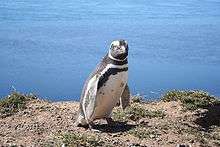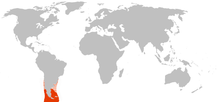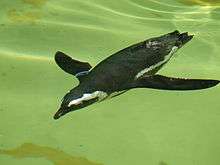Magellanic penguin
| Magellanic penguin | |
|---|---|
 | |
| Valdes Peninsula | |
| Scientific classification | |
| Kingdom: | Animalia |
| Phylum: | Chordata |
| Class: | Aves |
| Order: | Sphenisciformes |
| Family: | Spheniscidae |
| Genus: | Spheniscus |
| Species: | S. magellanicus |
| Binomial name | |
| Spheniscus magellanicus (Forster, 1781) | |
 | |
| Red area shows range | |
The Magellanic penguin (Spheniscus magellanicus) is a South American penguin, breeding in coastal Argentina, Chile and the Falkland Islands, with some migrating to Brazil where they are occasionally seen as far north as Rio de Janeiro. It is the most numerous of the Spheniscus penguins. Its nearest relatives are the African, the Humboldt penguin and the Galápagos penguins. The Magellanic penguin was named after Portuguese explorer Ferdinand Magellan, who spotted the birds in 1520. The species is listed as Near Threatened by the IUCN.[2]
Description


Magellanic penguins are medium-sized penguins which grow to be 61–76 cm (24–30 in) tall and weigh between 2.7 and 6.5 kg (6.0 and 14.3 lb).[3][4] The males are larger than the females, and the weight of both drops while the parents nurture their young.
Adults have black backs and white abdomens. There are two black bands between the head and the breast, with the lower band shaped in an inverted horseshoe. The head is black with a broad white border that runs from behind the eye, around the black ear-coverts and chin, and joins at the throat. Chicks and younger penguins have grey-blue backs, with a more faded grey-blue color on their chest. Magellanic penguins can live up to 25 years in the wild, but as much as 30 years in captivity.
Young birds usually have a blotched pattern on their feet, which fades as they grow up into adulthood. By the time these birds reach about ten years of age, their feet usually become all black.
Like other species of penguins, the Magellanic penguin has very rigid wings used to swim under water.
Diet
Magellanic penguins feed in the water, preying on cuttlefish, squid, krill, and other crustaceans, and ingest sea water with their prey. Their salt-excreting gland rids the salt from their bodies. Adult penguins can regularly dive to depths of between 20m to 50m deep in order to forage for prey. During the breeding season males and females have similar foraging and diving patterns as well as diet composition, however bone tissue analysis suggests that diets diverge post-season when limitations imposed by chick rearing are removed.[5]
Magellanic penguins do not experience a severe shortage of food like the Galapagos penguins, because they have a consistent food supply being located on the Atlantic coast of South America. The presence of the large continental shelf in the Atlantic Ocean lets Magellanic penguins forage far from their breeding colony.[6]
Breeding

Magellanic penguins travel in large flocks when hunting for food. In the breeding season, these birds gather in large nesting colonies at the coasts of Argentina, southern Chile, and the Falkland Islands, which have a density of 20 nests per 100 m2. The breeding season begins with the arrival of adult Magellanic penguins at the breeding colonies in September and extends into late February and March when the chicks are mature enough to leave the colonies.[5] One of the largest of these colonies is located at Punta Tombo.[7] Nests are built under bushes or in burrows. Two eggs are laid. Incubation lasts 39–42 days, a task which the parents share in 10- to 15-day shifts. The chicks are cared for by both parents for 29 days and are fed every two to three days. Normally, both are raised through adulthood, though occasionally only one chick is raised. A successful Magellanic is considered to be able to raise 0.7 chicks on average per breeding season.[8]
Magellanic penguins laid eggs in warm places where the temperature remain over 20℃.
The male and female penguins take turns hatching, as they forage far away from their nests. The males return from the sea on the day the second egg is laid to take their turn incubating[9] The second eggs are generally larger and with higher temperature than the first egg. So the first one is more likely to survive. But there are still conditions that both of the chicks are raised successfully.
Magellanic penguins mate with the same partner year after year. The male reclaims his burrow from the previous year and waits to reconnect with his female partner. The females are able to recognize their mates through their call alone.
Physiological Responses
Newly hatched chicks that are visited by tourists develop the stress response named Corticosterone. This is due to the amount of the times these chicks get visited and handled. Newly hatched chicks in tourist areas that are not visited by tourists do not develop any increases in this stress response. Having lower levels of this stress response is beneficial for these chicks so that they continue to gather muscle strength, growth, and a better functioning immune system.[10]
Status in the wild
Millions of these penguins still live on the coasts of Argentina and Chile, but the species is classified as threatened, primarily due to the vulnerability of large breeding colonies to oil spills, which kill 20,000 adults and 22,000 juveniles every year off the coast of Argentina. To help the fight against the oil spills, zoo representatives from all over the world come and adopt the hatch-lings, and breed them there. The decline of fish populations is also responsible, as well as predators such as sea lions, giant petrels, and leopard seals which prey on the chicks. The warrah, before it became extinct, also preyed on the penguin.
Climate change has displaced fish populations, so Magellanic penguins must swim an extra 40 km (25 miles) further from the nest for fish. While the penguins are swimming an extra 80 km (50 miles), their mates are sitting on a nest and starving. A colony being tracked by University of Washington professor P. Dee Boersma, about 1,600 km (1,000 miles) south of Buenos Aires, has fallen by more than 20 percent in the past 22 years, leaving 200,000 breeding pairs. Some younger penguins are now moving their breeding colonies north to be closer to fish, but, in some cases, this is putting them on private, unprotected lands. As a result of these changes, some penguins are known to have been lost or confused.[11] At present, 12 of 17 penguin species are experiencing rapid population declines. A recent study of professor Dee Boersma showed that an increase of rainstorms caused by climate change affecting weather patterns has had a large impact in the chicks' population. The chicks haven't yet grown waterproof feathers so they are more likely to die of hypothermia when they get wet during big storms.[12]
Increased frequency of extreme events, such as storms, drought, temperature extremes, and wildfires, associated with climate change, increases the reproductive failure in Magellanic penguins.
Conservation
The provincial government of Chubut is committed to the creation of a MPA in order to protect the penguins and other marine species near the largest Magellanic breeding colony. The creation of a MPA would likely improve the breeding success of the colonies as well as increase prey availability, reduce foraging distance, and increase feeding frequency.[8]
References
- ↑ BirdLife International (2012). "Spheniscus magellanicus". IUCN Red List of Threatened Species. Version 2013.2. International Union for Conservation of Nature. Retrieved 26 November 2013.
- ↑ [BirdLife International (2015) Species factsheet: Spheniscus magellanicus. Downloaded from http://www.birdlife.org on 01/12/2015. Recommended citation for factsheets for more than one species: BirdLife International (2015) IUCN Red List for birds. Downloaded from http://www.birdlife.org on 01/12/2015. "BirdLife International"] Check
|url=value (help). - ↑ BBC.co.uk
- ↑ Answers-.penguin
- 1 2 Silva, Laura (May 2014). "Differences in diet composition and foraging patterns between sexes of the Magellanic penguin ( Spheniscus magellanicus) during the non-breeding period as revealed by δC and δN values in feathers and bone.". Marine Biology. doi:10.1007/s00227-014-2410-1.
- ↑ Akst, Elaine P.; Boersma, P. Dee; Fleischer, Robert C. (2002-12-01). "A comparison of genetic diversity between the Galápagos Penguin and the Magellanic Penguin". Conservation Genetics. 3 (4): 375–383. doi:10.1023/A:1020555303124. ISSN 1566-0621.
- ↑ C. Michael Hogan (2008) Globaltwitcher.auderis.se, Magellanic Penguin, ed. N. Stromberg]
- 1 2 Boersma, Dee (February 2015). "Marine protection is needed for Magellanic penguins in Argentina based on long-term data". Biological Conservation. doi:10.1016/j.biocon.2014.12.005.
- ↑ Journal of Avian Biology 46: 001–010, 2015 doi: 10.1111/jav.00662 Barrionuevo, M. Frere, E..
- ↑ Walker, Brian (October 2005). "Physiological and Behavioral Differences in Magellanic Penguin Chicks in Undisturbed and Tourist-Visited Locations of a Colony". Conservation Biology. 19 (5): 1571–1577. doi:10.1111/j.1523-1739.2005.00104.x.
- ↑ "Confused penguin strays 5,000km". BBC News. 11 May 2007.
- ↑ Netburn, Deborah (January 31, 2014). "Why baby Magellanic penguins are dying in the rain". Los Angeles Times. Retrieved 31 January 2014.
- Planetark.org, 16 February 2009
External links
| Wikimedia Commons has media related to Spheniscus magellanicus. |
- Puntatombo.com
- Magellanic Penguins in Chilean Patagonia
- Video - Magellanic penguin chicks at the San Francisco Zoo
- Video - March of the Penguin Chicks at the San Francisco Zoo
- Magellanic penguins from the International Penguin Conservation website
- Penguin World: Magellanic penguin
- Pinguins.info, information about all species of penguins
- Adopt a Magellanic penguin
- A confused Magellanic penguin strays 5000km off course
- Roscoe, R. "Magellanic Penguin". Photo Volcaniaca. Retrieved 13 April 2008.
